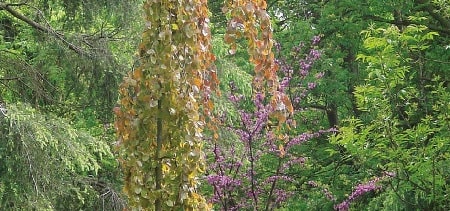It has a natural distribution from Europe to the Caucasus. In our country, it grows naturally in Strandja Mountains. Its height is 30-40 m and crown width is 10-25 m. It is a round shaped tree. Its summer green leaves are receptive, 5-10 cm long, broadly elliptic ovate. The leaf margin is slightly wavy. Fresh young leaves are hairy, glabrous when mature, glossy dark green on the upper side and light green on the lower side. In autumn they turn vivid yellow to reddish brown. Flowers are monoecious, inconspicuous, unnoticeable. It grows well in both very sunny and shady places, in dry fresh soil. It prefers fresh calcareous soils but can also grow in slightly acidic and nutrient-poor soils. It is shade-tolerant but very sensitive to late frosts and sudden exposure to sunlight.
Roots are very sensitive to mechanical effects caused by excavation work. Tall, well-developed seedlings should be watered abundantly in the summer of the year they are planted. It is very aesthetic with its rounded top roof. It is used solitary in parks and gardens. It is also a very good mass and shade tree. For small gardens, Fagus sylvatica can be used as a hedge and topiary plant. Fagus sylvatica ‘Atropurpurea’ is 15-20 m tall and 8-10 m wide. While it develops in a conical form at a young age, the adult form is round. Leaves are intense red in spring, green and red in fall. Fruits are reddish brown.

- Fagus sylvatica, Common Beech or European Beech:
- Fagus sylvatica is a deciduous tree that can grow over 30 meters, with branches high on the trunk, or shorter in open areas.
- Found in large parts of Europe, it reaches approximately 35 meters in height and width.
- Habitat and Growing Conditions:
- Common beech thrives in various soils with good drainage but may struggle in moisture-retentive or waterlogged locations.
- It requires a humid atmosphere for optimal growth.
- Beech can be challenging to establish, with root growth beginning after bud burst.
What is made from Fagus sylvatica wood?
Fagus sylvatica, commonly known as European beech, is valued for its strong and durable wood, which has a pale cream color and a fine, uniform texture. The wood of Fagus sylvatica is used in various applications, including:
- Furniture: European beech wood is widely used in the production of furniture. Its fine grain and light color make it suitable for a range of furniture styles. It is often used in the construction of chairs, tables, cabinets, and other pieces.
- Flooring: Beech wood is also employed in the manufacturing of flooring. Its hardness and wear resistance make it suitable for use in high-traffic areas.
- Cabinetry: The wood is used in the production of cabinets and cupboards due to its strength and smooth finish.
- Musical Instruments: European beech is sometimes used in the construction of musical instruments, particularly for parts like guitar bodies and piano frames.
- Tool Handles: The wood’s strength and shock resistance make it suitable for tool handles, such as those for hammers and chisels.
- Turning and Carving: European beech is favored by woodturners and carvers for its workability, allowing for intricate designs and smooth finishes.
It’s important to note that while European beech has a variety of applications, the specific use of the wood can depend on factors such as its quality, color, and grain pattern. Additionally, beech wood is often used in combination with other woods in certain applications.
